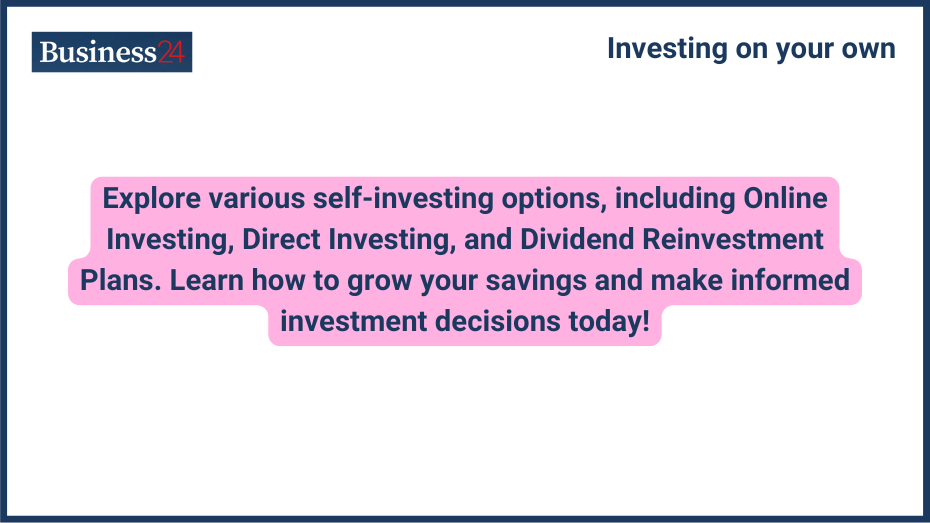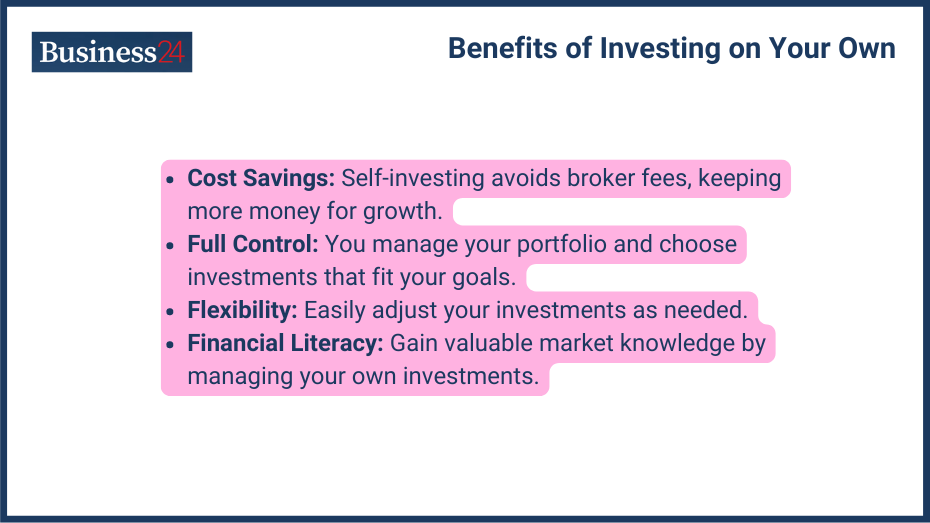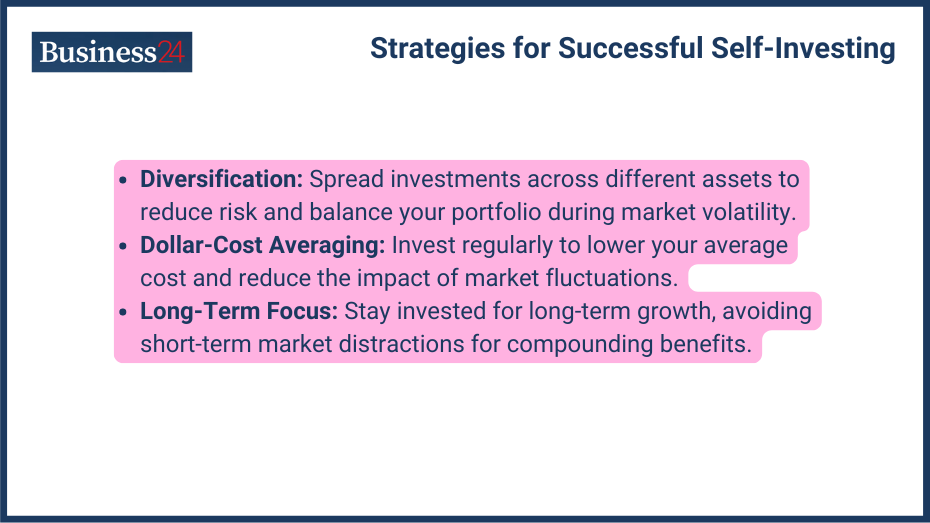
Explore various self-investing options, including Online Investing, Direct Investing, and Dividend Reinvestment Plans. Learn how to grow your savings and make informed investment decisions today!
Taking Charge of Your Financial Future
Planning your financial investment feels intimidating. Where to begin? How to plan? How do you choose between the vast financial assets? Lots of questions come to mind for beginners. You need take the first step, and it is essential not to get overwhelmed while taking this step toward your financially secure future.
Self-investing is crucial for a secure financial future. The fees involved in self-investing are less, and it provides flexibility and total control over investments. You have the freedom to decide where to invest, how much to invest, and how long to hold your investment.
Making personal financial decisions empowers you to achieve the specific goals and requirements that you have in mind. By making sound decisions, you grow money over time, and can make your dreams come true.
Today, we will examine all the aspects of self-investing, from getting started to building strategies, the potential risks, and the resources available to help you thrive as a DIY investor. This will allow you to begin self-investing today and take small steps toward your secure financial future!
Benefits of Investing on Your Own

- Cost Savings: One advantage of self-investing is saving on fees and commissions. These are charged by investment managers, financial advisors, and brokers. Even if the fee looks small upfront, it significantly impacts your investment growth over the long term. This significantly affects your returns over time. By investing yourself, you eliminate these fees, maintaining more of your capital for compound growth.
- Full Control Over Decisions: You will manage your investment portfolio and make decisions independently. You can choose assets to include in your portfolio and diversify as much as you like. This allows for greater flexibility and customization, as you can tailor your investments to your specific goals and risk tolerance. By taking control of your investments, you’ll have a deeper understanding of the financial markets and be able to make more informed decisions.
- Flexibility and Customization: Self-investing offers unparalleled flexibility and customization. You have the power to decide exactly what your money is invested in, allowing you to align your investments with your personal goals and risk tolerance. As your circumstances change, you can easily modify your portfolio to reflect your evolving needs and preferences.
- Financial Literacy: Self-investing is a powerful tool for building financial literacy. You’ll gain valuable experience and knowledge about the financial markets by actively managing your portfolio. Over time, you’ll better understand investment concepts, risk management, and market trends. This increased financial awareness will enable you to make more informed decisions and improve your financial well-being.
Getting Started with Self-Investing
Before you start investing, you will need a brokerage account for stocks, bonds, and mutual funds. Every broker has different investment options, features, fees, and customer service. Factors to consider when selecting online brokers are the user experience they provide, annual fees charged by them, tools on the platform, etc. Various online tools are also available that provide real-time data for analyzing the markets.
You should create a diversified portfolio by investing in different classes of assets, such as stocks, bonds, mutual funds, and ETFs.
There are two types of investing accounts: taxable and tax-advantaged. Taxable accounts are more flexible and limit invested amounts, but capital gains and dividends are taxed. In tax-advantaged accounts, investments grow tax-free. Individual Retirement Accounts (IRAs) and 401(k)s are examples of tax-advantaged accounts.
Strategies for Successful Self-Investing

- Diversification: Diversifying your portfolio across various asset classes is a powerful strategy for mitigating risk. By spreading your investments across different types of assets, you can reduce the impact of market volatility.
When one asset class is underperforming, others may be doing well, helping to balance your overall portfolio. Diversifying can enhance your risk-adjusted returns and provide a more stable investment experience. - Dollar-Cost Averaging: Dollar-cost averaging is a disciplined investment approach that can help you reduce the average price per share over time. By investing a fixed amount at regular intervals, you’ll buy more when prices are low and fewer when prices are high.
This strategy can help mitigate the impact of market fluctuations and potentially lower your overall cost basis. - Long-Term Focus: Investing for the long term is essential for reaping the benefits of compounding. Avoid getting caught up in short-term market fluctuations and maintain a disciplined approach.
Even if there are temporary downturns, staying invested through market volatility can allow you to benefit from your investments’ long-term growth potential. Remember, patience and discipline are key to successful long-term investing.
Potential Risks of Investing on Your Own
- Lack of Professional Guidance: You miss out on making informed decisions since you are investing without a professional financial advisor. This could lead to poor investment choices. You could also miss out on possible tax optimizations and adjustments based on changing financial goals.
- Emotional Investing: The noise in the market causes investors to make emotional decisions in fear and greed. This leads to losses, and they make even more poor decisions to cover these losses. Staying to one plan and backtest it is important, maintaining a long-term perspective. Reacting to short-term trends will not help when your goal is to invest for decades.
Tools and Resources for DIY Investors
There is a large number of online brokers to choose from, and you can decide based on the user experience, service quality, collection of assets provided, annual fees, etc. Also, lots of online tools for managing your portfolios and analyzing the assets are available for free like chart analyzing software for technical analysis and websites that provide financial information about companies for fundamental analysis.
Vast resources, ranging from articles to video tutorials and courses, are available online for learning purposes. These will help deepen your understanding of the markets and investment strategies.
Conclusion: Empower Yourself Through Self-Investing
We have understood that investing on your own is a great way to improve your financial future. You have cost savings and more flexibility and will achieve financial literacy using the right strategies, tools, and resources. However, self-investing requires discipline, a long-term focus, and managing risks like emotional decision-making and lack of professional guidance.
You can start with a small capital and invest in a few assets to gain some experience, and as you keep learning, steadily increase and modify your investment capital and strategy. So go ahead, start small, educate yourself continuously, and embrace the empowerment of making personal financial decisions. Doing so can build a secure financial future on your own terms.
Disclaimer
eToro is a multi-asset platform which offers both investing in stocks and cryptoassets, as well as trading CFDs.
Please note that CFDs are complex instruments and come with a high risk of losing money rapidly due to leverage. 51% of retail investor accounts lose money when trading CFDs with this provider. You should consider whether you understand how CFDs work, and whether you can afford to take the high risk of losing your money
This communication is intended for information and educational purposes only and should not be considered investment advice or investment recommendation. Past performance is not an indication of future results.
Copy Trading does not amount to investment advice. The value of your investments may go up or down. Your capital is at risk.
Don’t invest unless you’re prepared to lose all the money you invest. This is a high-risk investment and you should not expect to be protected if something goes wrong. Take 2 mins to learn more
eToro USA LLC does not offer CFDs and makes no representation and assumes no liability as to the accuracy or completeness of the content of this publication, which has been prepared by our partner utilizing publicly available non-entity specific information about eToro.
